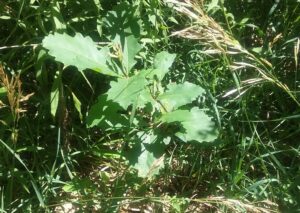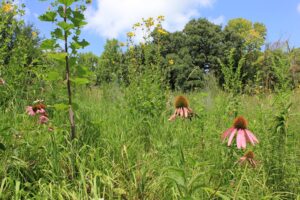habitat restoration
Bur oak trees are the keystone species for our upland community, but a demographic crisis is playing out before our eyes. Our land management team is working to restore the majestic oak savannas that once dominated this ecologically unique area.
Donate to Land Stewardship

habitat restoration
Hiking through Fontenelle Forest and Neale Woods, you may notice that the landscape is changing. We often get questions about dense stands of dying trees, dramatic new openings, and brush piles. All of this is a part of a multifaceted ecological restoration initiative in progress at Fontenelle Forest. Our land management team is working to restore the majestic oak savannas that once dominated this ecologically unique area between the Missouri River floodplain to the east and the tallgrass prairie to the west. We are at the precipice of a critical turning point to restore our oak systems before they are lost forever.
Bur oak trees are the keystone species for our upland community, but a demographic crisis is playing out before our eyes. Oak trees can live for hundreds of years, but compared to other trees, they grow much, much slower. Most of our bur oaks are senior citizens. Every mast year, these ancient oaks are producing fewer and fewer viable acorns. That makes every young bur oak sprout immensely valuable.
 Over the last 200 years, we have removed all the historical disturbances that kept the system in balance. Without the aid of fire, elk, and bison, a multitude of invasive species and an overabundance of woody plants have taken the place of prairie grasses and forbs. These fast-growing woody plants have grown up and around the remaining oak sprouts, depriving them of sunlight. So while an oak may sprout, it won’t get enough sunlight to make it past the first year.
Over the last 200 years, we have removed all the historical disturbances that kept the system in balance. Without the aid of fire, elk, and bison, a multitude of invasive species and an overabundance of woody plants have taken the place of prairie grasses and forbs. These fast-growing woody plants have grown up and around the remaining oak sprouts, depriving them of sunlight. So while an oak may sprout, it won’t get enough sunlight to make it past the first year.
Therefore, we are setting back the clock. Every year, land management staff and volunteers are diligently removing undesirable woody overgrowth and invasive species with chainsaws, brush cutters, skid loaders, and herbicides. Biologists identify where there are valuable plant communities in abundance and ensure these remain intact. Where these are not present, we prepare the soil for native savanna seeds. Into the newly exposed and sunny soil, volunteers sow seed into these openings with native prairie species from local sources. The work does not stop there, or ever for that matter. These areas will be annually burned through prescribed fire or mowed to simulate grazing. Biologists will continue expanding these openings and creating habitat corridors to connect the openings and allow for the movement of native species between them. All areas are continually monitored for the emergence of new invasive or valuable species that could threaten or improve our system.

Habitat restoration requires immense commitment, patience, and strategic long-term attention. None of this could happen without the support of our community stakeholders, who communicate our mission, volunteer time in the field, and donate to keep our restoration work in motion. While the work area may look at times like a construction site, give it a few years. Return after the seeds have had time to stratify and germinate after the birds and pollinators have discovered the location. Much like the colorful prairie openings that can be found at Neale Woods, you’ll find an explosion of biodiversity returning, the sounds and sights of which haven’t been heard or seen there for a century.
Through the support of our members and donors, these little oaks will become the mighty giants of a mature oak savanna.
See Brochure about efforts to save the oaks
Learn more about what we do to manage Fontenelle Forest:
- GIS: By using GIS, it is easier to change a map and be more accurate about the portrayal of our trails on paper. Learn more here about how we use GIS information for conservation.
- Hack and squirt is a method of understory tree thinning and takes place in areas where over-abundant shade-tolerant trees (hackberry, elm, ironwood, and basswood) are too thick. Learn more about this tool in our conservation toolbox here.
- Plant and insect surveys are a part of our ecological monitoring. It’s important to track the changes in plant, animal, and insect life in the Forest to inform our Forest Management plan and help us understand how the Forest is changing. Learn more about our surveys here.
- Community Outreach: One of the objectives of our Oak Woodland Restoration grant from the Nebraska Environmental Trust is to inform and educate the public about our conservation efforts. There are targeted outreach audiences, as well. We attend conferences and meetings in the conservation community. We participate in forums, give presentations, and engage in conversations with other land management practitioners about best practices and new research as well as challenges and successes. Learn more about our community outreach efforts here.
- Daily life of a ranger, researcher, or land steward: Each morning, we get in our cars drive through the city, and see many individuals dragging along, drinking coffee and reluctantly heading to their place of employment. Our daily work operations, at Fontenelle Forest, whether it is winter, spring, summer, or fall is always different and monotony isn’t a word we use around these parts. Learn more about the daily life of a land steward here.
- Research: Student projects from the University of Nebraska at Lincoln tackled restoration issues at Fontenelle Forst from invasive species to urban fire and others. You can learn more about the projects here.
- Oak Woodland Restoration: Watch the video below, which explains canopy thinning as a tool used for oak woodland restoration.
Questions?
If you would like more information about oak savanna restoration, please call our Visitor Services desk at 402-731-3140 and ask to speak to one of our biologists.


